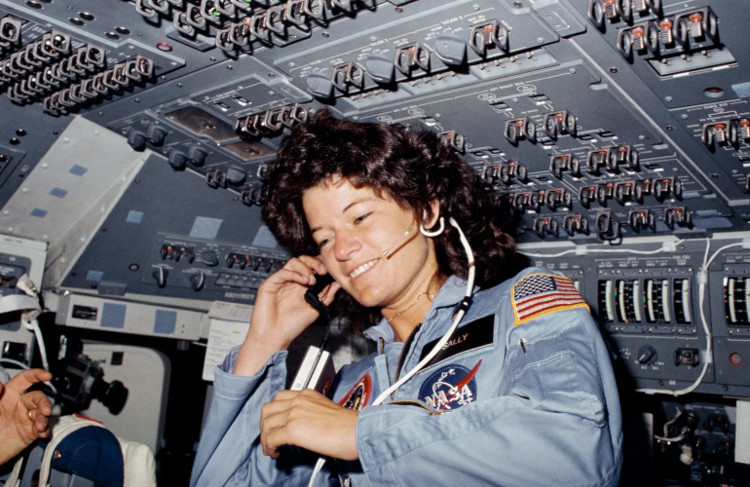The story of 'coming months' when traveling once again made NASA headache
Menstruation is an unpleasant experience. But if the female astronauts unfortunately "come months" right in the universe, what will happen? In the place where the liquid floats in mid-air, how will they handle it?
In the early days of NASA's conquest of the universe, the "to month" story while in the universe has always been a strange and mysterious topic. Therefore, it was not until 1983 that the history of the first astronaut was a woman.
The astronaut named Sally Ride , and was accompanied by an extraordinarily generous "accessory" of 100 tampons for the mission lasting only a week.

Sally Ride - female astronaut on duty with a package of 100 tampons.
NASA's anxiety was then completely grounded, because until before that time, no one knew how micro-gravity environments would affect menstruation. How will blood flow, be it backflowed, or cause negative health events?
Fortunately, it turns out that the story to the month in the universe is no different from Earth. So since then, female astronauts continue to perform tasks in the universe without any problems.
However, this same story recently started to make NASA think. The problem is that all the menstrual documents in the universe are only recorded in short-term tasks.
So what will happen with long-term tasks? This is an extremely important question, to serve the campaign to travel to Mars in 2030.
Why is menstruation now a problem?
As mentioned, menstruation in the universe is not much different than on Earth. However, personal hygiene in the universe is relatively difficult - especially in terms of water supply .
Above, the water treatment system is not designed to deal with menstrual blood, as it also relates to the system of recycling water into drinking water. Ie basically, menstruation in the universe is a very inconvenient experience.
So to avoid trouble, female travelers must find ways to delay menstruation , and they have some solutions. The first is drinking to postpone the business when on duty. It will increase estrogen levels, making the egg not fall off for a certain amount of time.

Basically, menstruation in the universe is a very inconvenient experience.
The next solution is the IUD - the IUD - which is inserted into the uterus . Substances such as copper or hormones in the ring (such as progesterone) will affect the mucus on the uterus, preventing the ovulation process, causing less ovulation.
Finally inject hormone ! This method is similar to placing a ring, and has a "term" of use within 2-3 years.
Which method is the safest
According to Kristin Jackson - a physiotherapist in Florida, the best solution is the birth control pill and. The reason is simply because of safety.
"They're absolutely safe when used to delay menstruation," she said.
"But these methods are only postponed, and they are not 100% guaranteed. Each person has a different basis, but some methods are indeed more effective."
However, Jackson also warned that the most secure method does not mean the safest. That is the type of hormone injection.
"After monitoring patients using this form, we find side effects are osteoporosis gradually. When you have to live in micro-gravity environment, it will be a huge problem."
Another expert, Varsha Jain from University of London, said: "Research on female soldiers shows that a lot of women want to postpone their work when they are on duty, so it is impossible for astronauts to do it. what's wrong ".
However, in terms of contraceptive methods, Jain also points out a relatively ominous problem, which is the supply of medicine . To complete the 3-year mission, it is estimated that 1,100 pills are needed, and this amount of medicine occupies a large area in the cargo compartment which must be prioritized for other necessities.
Furthermore, there are reports that oral contraceptives can cause osteoporosis. So, the best solution now is to set the ring. Can be placed before the cast mission, to ensure that the ring does not need to be replaced until they return to Earth.
The study was published in Microgravity magazine.
- Headache - symptoms of many causes
- Good foods for people or headaches
- Eat 'standard' to dispel headaches
- Top 5 causes of headaches in the summer
- Headache when you need a CT scan, MRI?
- Decode the feeling of headache when flying
- Things to remember before traveling
- The origin 'no one knows - no one knows' in the names of the months
- 9 common headaches and treatment
- NASA will create fuel for missiles from ... Mars land
- The dream of traveling the universe by
- If you know how to fold this, you can bring a traveling wardrobe
 Van Allen's belt and evidence that the Apollo 11 mission to the Moon was myth
Van Allen's belt and evidence that the Apollo 11 mission to the Moon was myth The levels of civilization in the universe (Kardashev scale)
The levels of civilization in the universe (Kardashev scale) Today Mars, the sun and the Earth are aligned
Today Mars, the sun and the Earth are aligned The Amazon owner announced a secret plan to build a space base for thousands of people
The Amazon owner announced a secret plan to build a space base for thousands of people